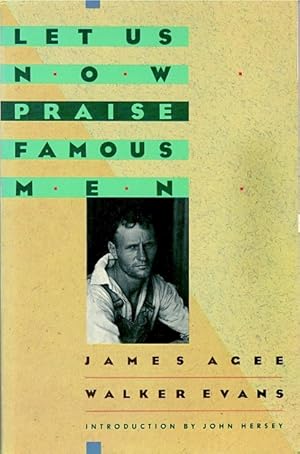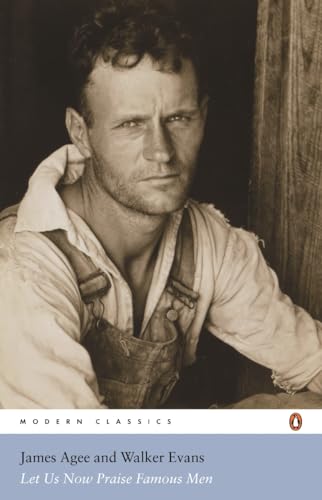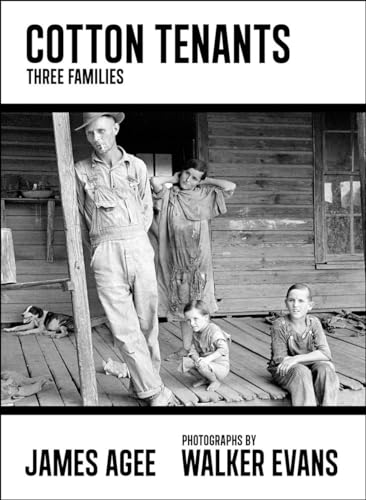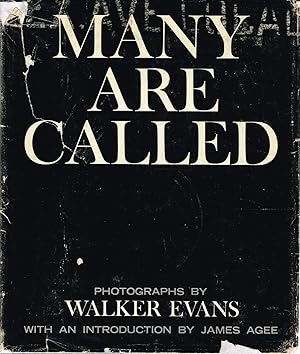Evans Walker Introduction James Agee (6 results)
FeedbackSearch filters
Product Type
- All Product Types
- Books (6)
- Magazines & Periodicals (No further results match this refinement)
- Comics (No further results match this refinement)
- Sheet Music (No further results match this refinement)
- Art, Prints & Posters (No further results match this refinement)
- Photographs (No further results match this refinement)
- Maps (No further results match this refinement)
- Manuscripts & Paper Collectibles (No further results match this refinement)
Condition
Binding
Collectible Attributes
- First Edition (3)
- Signed (No further results match this refinement)
- Dust Jacket (2)
- Seller-Supplied Images (4)
- Not Print on Demand (6)
Language (2)
Free Shipping
- Free Shipping to U.S.A. (No further results match this refinement)
Seller Location
Seller Rating
-
Let Us Now Praise Famous Men: Three Tenant Families
Published by Houghton Mifflin Company, Boston, 1988
ISBN 10: 0395488974 ISBN 13: 9780395488973
Language: English
Seller: LEFT COAST BOOKS, Santa Barbara, CA, U.S.A.
Paperback. Condition: Very Good. liv, 471 pages, [61] pages of plates, illustrations; 22 cm. Tight, clean copy. Light edgewear to wraps, age toning. *** Depression-era classic on sharecroppers, with stunning photographs by Walker Evans. Born in Tennessee, James Agee (1909-1955) spent the summer of 1936 with photographer Walker Evans among the sharecroppers of Alabama, which resulted in the famous collaborative book, Let Us Now Praise Famous Men (1941). His autobiographical novel, A Death in the Family (1957) was awarded the Pulitzer Prize. He also wrote poetry, screenwriting, and film criticism. Size: 8vo.
-
£ 14.30
Convert currency£ 10 shipping from United Kingdom to U.S.A.Quantity: 2 available
Add to basketPaperback. Condition: Brand New. 512 pages. 7.76x5.16x1.46 inches. In Stock.
-
£ 37.95
Convert currency£ 10 shipping from United Kingdom to U.S.A.Quantity: 1 available
Add to basketHardcover. Condition: Brand New. 160 pages. 7.75x6.00x0.75 inches. In Stock.
-
MANY ARE CALLED: PHOTOGRAPHS BY WALKER EVANS
Published by Houghton Mifflin Company & The Riverside Press, Boston & Cambridge, MA, 1966
First Edition
Boards in Pictorial Jacket. Condition: Very Good. Dust Jacket Condition: Good. First Edition. xii + 178pp, 89 b&w illustrations. Published in 1966, this hardbound monograph collected in book form for the first time Walker Evans' poignant black and white portraits of New York City subway riders taken during the thirties and forties. An otherwise internally bright, most handsome example of the uncommon Houghton Mifflin Company and Riverside Press first hardcover edition (cited on page 253 of Martin Parr and Gerry Badger's "The Photobook: A History Volume I", pages 218-219 of The Hasselblad Center's "The Open Book", page 31 of "From Fair to Fine: 20th Century Photography Books That Matter", and pages 104-109 of Horacio Fernandez' "New York in Photobooks") showing some minor staining and the name of a previous owner in ink on the front pastedown. The embossed white lettering on the front board and spine is still strong and crisp, while the black covers show a few trivial traces of water droplets in raking light along with a minor scratch on the rear board. Its fragile dust jacket is present, though noticeably creased, chipped, and torn - with some paper loss. It has been priced accordingly. Photography Monograph.
-
Many Are Called
Published by Houghton Mifflin, New York, 1966
Seller: A&D Books, South Orange, NJ, U.S.A.
First Edition
Hardcover. First edition, first printing. Very Good+ hardcover with crisp white lettering to the black cloth and light rubbing at the extremities in a Poor dust jacket with loss at the heel, crown and tips and a one-inch by one-inch chip to the front and wear at the edges. All five panels of the dust jacket are present but the front flap has separated and the front and back panels are separated at the spine; the pieces are held together by a mylar cover that gives the appearance of being whole. BOOKS SHIP THE NEXT BUSINESS DAY, WRAPPED IN PADDING, IN A BOX. 178 pages; 90 b&w plates; 9.75 x 8 inches. Errata slip bound in. In 1938, Walker Evans began surreptitiously photographing people on the New York City subway. With his camera hidden in his coat, he captured the faces of riders hurtling through the dark tunnels, wrapped in their own private thoughts. By 1940-41, Evans had made over six hundred photographs and had begun to edit the series. The book remained unpublished until 1966 when The Museum of Modern Art mounted an exhibition of Evans's subway portraits.
-
Many Are Called
Published by Houghton Mifflin Company, Boston, 1966
Seller: Lorne Bair Rare Books, ABAA, Winchester, VA, U.S.A.
First Edition
First Edition. First Printing, softcover issue. Octavo (21.25cm); original printed card wrappers; [xiv],178pp, with erratum slip tipped in following the dedication page; illus. Modest wear and rubbing to wrappers (particularly along the joints), base of spine gently bumped; contents clean; Very Good+. A collection of photographs by Evans taken on the New York subway during the 1930s and 40s, with an introduction by James Agee. ".Evans concealed a Contax camera beneath his coat, so that he could snap subway passengers without their knowledge. Framing and focusing were left somewhat to chance, the only conscious decision being when to release the shutter" (PARR & BADGER, Vol.1, p.253). 84431.







